
Calanque
Encyclopedia
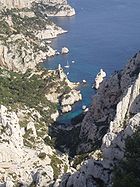
Limestone
Limestone is a sedimentary rock composed largely of the minerals calcite and aragonite, which are different crystal forms of calcium carbonate . Many limestones are composed from skeletal fragments of marine organisms such as coral or foraminifera....
, dolomite
Dolomite
Dolomite is a carbonate mineral composed of calcium magnesium carbonate CaMg2. The term is also used to describe the sedimentary carbonate rock dolostone....
, or other carbonate
Carbonate minerals
Carbonate minerals are those minerals containing the carbonate ion: CO32-.-Anhydrous carbonates:*Calcite group: Trigonal**Calcite CaCO3**Gaspeite CO3**Magnesite MgCO3**Otavite CdCO3**Rhodochrosite MnCO3**Siderite FeCO3**Smithsonite ZnCO3...
strata
STRATA
Strata Marketing Inc. is a Chicago, Illinois-based software company involved in connecting media buyers and sellers. It is owned by Comcast. As of 2010, it processes about $50 billion worth of media buys annually.-History:...
and found along the Mediterranean coast. A calanque is a steep-sided valley formed within karstic regions either by fluvial
Fluvial
Fluvial is used in geography and Earth science to refer to the processes associated with rivers and streams and the deposits and landforms created by them...
erosion or the collapse of the roof a cave that has been subsequently partially submerged by a rise in sea level
Sea level
Mean sea level is a measure of the average height of the ocean's surface ; used as a standard in reckoning land elevation...
. It can be considered a Mediterranean fjord
Fjord
Geologically, a fjord is a long, narrow inlet with steep sides or cliffs, created in a valley carved by glacial activity.-Formation:A fjord is formed when a glacier cuts a U-shaped valley by abrasion of the surrounding bedrock. Glacial melting is accompanied by rebound of Earth's crust as the ice...
.
Location
The best known examples of this formation can be found in the Massif des Calanques (Massís dei calancas in Occitan, the local language) in the Bouches-du-RhôneBouches-du-Rhône
Bouches-du-Rhône is a department in the south of France named after the mouth of the Rhône River. It is the most populous department of the Provence-Alpes-Côte d'Azur region. Its INSEE and postal code is 13.-History of the department:...
département of France
France
The French Republic , The French Republic , The French Republic , (commonly known as France , is a unitary semi-presidential republic in Western Europe with several overseas territories and islands located on other continents and in the Indian, Pacific, and Atlantic oceans. Metropolitan France...
. This range extends for 20 km in length and 4 km in width along the coast between Marseille
Marseille
Marseille , known in antiquity as Massalia , is the second largest city in France, after Paris, with a population of 852,395 within its administrative limits on a land area of . The urban area of Marseille extends beyond the city limits with a population of over 1,420,000 on an area of...
and Cassis
Cassis, Bouches-du-Rhône
Cassis is a commune situated east of Marseille in the department of Bouches-du-Rhône in the Provence-Alpes-Côte d'Azur region in southern France....
, culminating in Marseilleveyre (432 m) and Mont Puget
Mont Puget
Mont Puget, named after the French sculptor Pierre Puget, is a mountain, part of Marseille-Cassis calanques, located south-east of Marseille.Like most Marseille mountains, it is formed from limestone.- Tourism :...
(565 m). Similar calanques can also be found on the French riviera
French Riviera
The Côte d'Azur, pronounced , often known in English as the French Riviera , is the Mediterranean coastline of the southeast corner of France, also including the sovereign state of Monaco...
near Estérel
Esterel
Esterel is a synchronous programming language for the development of complex reactive systems. The imperative programming style of Esterel allows the simple expression of parallelism and preemption...
and on the island of Corsica
Corsica
Corsica is an island in the Mediterranean Sea. It is located west of Italy, southeast of the French mainland, and north of the island of Sardinia....
(see Calanques de Piana). Similarities are seen between calanques, and ria
Ria
A ria is a coastal inlet formed by the partial submergence of an unglaciated river valley. It is a drowned river valley that remains open to the sea. Typically, rias have a dendritic, treelike outline although they can be straight and without significant branches. This pattern is inherited from the...
s, the river mouths formed along the coast of Brittany
Brittany
Brittany is a cultural and administrative region in the north-west of France. Previously a kingdom and then a duchy, Brittany was united to the Kingdom of France in 1532 as a province. Brittany has also been referred to as Less, Lesser or Little Britain...
in Northern France.

Calanque de Sormiou
The Calanque de Sormiou is one of the big Calanques between Marseille and La Ciotat.It is famous for its climbing spots. Access by car is restricted due to the risk of forest fires....
, the Calanque de Morgiou
Calanque de Morgiou
The Calanque de Morgiou is one of the biggest calanques located between Marseille and Cassis.Formerly a fishing port, it is famous for the gigantic tuna fishing organized there in 1622, when the king Louis XIII paid a visit to Marseille...
, the Calanque d'En-Vau, the Calanque de Port-Pin and the Calanque de Sugiton
Calanque de Sugiton
The Calanque de Sugiton is one of the numerous calanques located between Marseille and Cassis.While quite small, Sugiton is perhaps the most known of all Marseille calanques, simply because it can be easily accessed by hikers, and because it is open to tourists even during hot season, unlike most...
. Calanques are also present in the Italian Apennines, in location such as the Accona Desert
Accona Desert
The Accona Desert is a semi-arid area in Tuscany, Italy, in the center of the so-called Crete senesi, near the comune of Asciano...
and in the Calanchi natural preserve of Atri
Atri, Italy
Atri is a comune in the Province of Teramo in the Abruzzo region of Italy. It has a population of over 11,500...
.
Geology
Modern day calanques along the Mediterranean Sea are steep-sided valleys that the HoloceneHolocene
The Holocene is a geological epoch which began at the end of the Pleistocene and continues to the present. The Holocene is part of the Quaternary period. Its name comes from the Greek words and , meaning "entirely recent"...
(Flandrian) marine transgression partially submerged to form cliff-edged inlets. These valleys were either incised by river
River
A river is a natural watercourse, usually freshwater, flowing towards an ocean, a lake, a sea, or another river. In a few cases, a river simply flows into the ground or dries up completely before reaching another body of water. Small rivers may also be called by several other names, including...
s or created by cave collaspe as karst
KARST
Kilometer-square Area Radio Synthesis Telescope is a Chinese telescope project to which FAST is a forerunner. KARST is a set of large spherical reflectors on karst landforms, which are bowlshaped limestone sinkholes named after the Kras region in Slovenia and Northern Italy. It will consist of...
ic dry valleys when sea level was lower than present.
Along the coast of the Mediterranean Sea, some of the valleys, which were flooded to form calanques, might date back to the Messinian salinity crisis
Messinian salinity crisis
The Messinian Salinity Crisis, also referred to as the Messinian Event, and in its latest stage as the Lago Mare event, was a geological event during which the Mediterranean Sea went into a cycle of partly or nearly complete desiccation throughout the latter part of the Messinian age of the Miocene...
between 5.96 to 5.32 million years ago. During this period of time, the Mediterranean Sea became isolated from the Atlantic Ocean
Atlantic Ocean
The Atlantic Ocean is the second-largest of the world's oceanic divisions. With a total area of about , it covers approximately 20% of the Earth's surface and about 26% of its water surface area...
and its sea level dropped at least 1,500 meters below the level of the Atlantic Ocean. As a result not only did evaporite
Evaporite
Evaporite is a name for a water-soluble mineral sediment that result from concentration and crystallization by evaporation from an aqueous solution. There are two types of evaporate deposits, marine which can also be described as ocean deposits, and non-marine which are found in standing bodies of...
s accumulated on the abyssal plain
Abyssal plain
An abyssal plain is an underwater plain on the deep ocean floor, usually found at depths between 3000 and 6000 metres. Lying generally between the foot of a continental rise and a mid-ocean ridge, abyssal plains cover more than 50% of the Earth’s surface. They are among the flattest, smoothest...
s of the Mediterranean Sea, but also river
River
A river is a natural watercourse, usually freshwater, flowing towards an ocean, a lake, a sea, or another river. In a few cases, a river simply flows into the ground or dries up completely before reaching another body of water. Small rivers may also be called by several other names, including...
s flowing into it deepened their valley
Valley
In geology, a valley or dale is a depression with predominant extent in one direction. A very deep river valley may be called a canyon or gorge.The terms U-shaped and V-shaped are descriptive terms of geography to characterize the form of valleys...
s by 100s of meters. For example, the Rhône River
Rhône River
The Rhone is one of the major rivers of Europe, rising in Switzerland and running from there through southeastern France. At Arles, near its mouth on the Mediterranean Sea, the river divides into two branches, known as the Great Rhone and the Little Rhone...
cut a canyon
Canyon
A canyon or gorge is a deep ravine between cliffs often carved from the landscape by a river. Rivers have a natural tendency to reach a baseline elevation, which is the same elevation as the body of water it will eventually drain into. This forms a canyon. Most canyons were formed by a process of...
as deep as 576 meters into Cretaceous
Cretaceous
The Cretaceous , derived from the Latin "creta" , usually abbreviated K for its German translation Kreide , is a geologic period and system from circa to million years ago. In the geologic timescale, the Cretaceous follows the Jurassic period and is followed by the Paleogene period of the...
carbonate strata near its confluence with its tributary the Ardèche. Fluvial erosion by smaller streams and rivers created numerous other deep, steep-sided valleys in response to the greatly lowered sea level at this time. Also at this time, steep-walled, dry karstic valleys were formed by the collapse of caves that developed in limestone, dolomite, and other carbonate rocks in response to the greatly lowered sea level of the Mediterranean Sea. Later, during the Pleistocene
Pleistocene
The Pleistocene is the epoch from 2,588,000 to 11,700 years BP that spans the world's recent period of repeated glaciations. The name pleistocene is derived from the Greek and ....
, these valleys were further enlarged and modified by fluvial, karst, and other processes during interglacial
Interglacial
An Interglacial period is a geological interval of warmer global average temperature lasting thousands of years that separates consecutive glacial periods within an ice age...
drops of sea level within the 100 meter range. During these periods of interglacial low sea level, additional steep-sided valleys, which were later flooded to create calanques, along the Mediterranean coastline were formed by fluvial and karst processes.
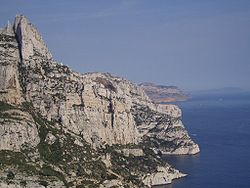
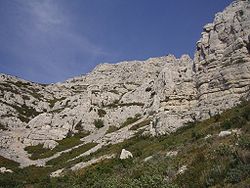
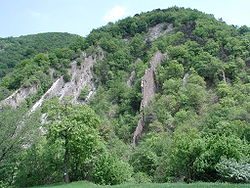
Ecosystem
The calanques have a particular ecosystemEcosystem
An ecosystem is a biological environment consisting of all the organisms living in a particular area, as well as all the nonliving , physical components of the environment with which the organisms interact, such as air, soil, water and sunlight....
, as soil
Soil
Soil is a natural body consisting of layers of mineral constituents of variable thicknesses, which differ from the parent materials in their morphological, physical, chemical, and mineralogical characteristics...
is almost non-existent there, and the limestone cliffs instead contain numerous cracks into which the roots of plants are anchored. In places where cliffs are less vertical, their vegetation is a classical Mediterranean maquis
Maquis shrubland
thumb|220px|Low Maquis in Corsica.220px|thumb|High macchia in Sardinia.Maquis or macchia is a shrubland biome in the Mediterranean region, typically consisting of densely growing evergreen shrubs such as holm oak, tree heath, strawberry tree, sage, juniper, buckthorn, spurge olive and myrtle...
, typically consisting of densely-growing evergreen shrub
Shrub
A shrub or bush is distinguished from a tree by its multiple stems and shorter height, usually under 5–6 m tall. A large number of plants may become either shrubs or trees, depending on the growing conditions they experience...
s such as sage
Salvia
Salvia is the largest genus of plants in the mint family, Lamiaceae, with approximately 700-900 species of shrubs, herbaceous perennials, and annuals. It is one of several genera commonly referred to as sage. When used without modifiers, sage generally refers to Salvia officinalis ; however, it is...
, juniper
Juniper
Junipers are coniferous plants in the genus Juniperus of the cypress family Cupressaceae. Depending on taxonomic viewpoint, there are between 50-67 species of juniper, widely distributed throughout the northern hemisphere, from the Arctic, south to tropical Africa in the Old World, and to the...
and myrtle. It is similar to heath
Heath (habitat)
A heath or heathland is a dwarf-shrub habitat found on mainly low quality acidic soils, characterised by open, low growing woody vegetation, often dominated by plants of the Ericaceae. There are some clear differences between heath and moorland...
in many aspects, but with taller shrubs, typically 2-4 m high as opposed to 0.2-1 m for heath.
Like anywhere on Mediterranean coast, Calanques' climate is arid, with any moisture coming only from evaporation of the sea. This xericity associated with the salt spray conditions the subsistence of an adapted vegetation.
The calanques also shelter rabbit
Rabbit
Rabbits are small mammals in the family Leporidae of the order Lagomorpha, found in several parts of the world...
s, fox
Fox
Fox is a common name for many species of omnivorous mammals belonging to the Canidae family. Foxes are small to medium-sized canids , characterized by possessing a long narrow snout, and a bushy tail .Members of about 37 species are referred to as foxes, of which only 12 species actually belong to...
es, large crow
Crow
Crows form the genus Corvus in the family Corvidae. Ranging in size from the relatively small pigeon-size jackdaws to the Common Raven of the Holarctic region and Thick-billed Raven of the highlands of Ethiopia, the 40 or so members of this genus occur on all temperate continents and several...
s and the Bonelli eagle, as well as many reptile
Reptile
Reptiles are members of a class of air-breathing, ectothermic vertebrates which are characterized by laying shelled eggs , and having skin covered in scales and/or scutes. They are tetrapods, either having four limbs or being descended from four-limbed ancestors...
s and wild boar
Boar
Wild boar, also wild pig, is a species of the pig genus Sus, part of the biological family Suidae. The species includes many subspecies. It is the wild ancestor of the domestic pig, an animal with which it freely hybridises...
s.
Tourism
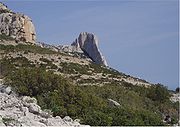
Corniche des Crêtes
The Corniche des Crêtes is a picturesque and narrow coastal road in the south of France, winding from Cassis to La Ciotat along the Mediterranean shore....
and Cap Canaille
Cap Canaille
Cap Canaille is a 1983 French drama film directed by Juliet Berto and Jean-Henri Roger. It was entered into the 33rd Berlin International Film Festival.-Cast:* Juliet Berto as Paula Baretto* Richard Bohringer as Robert Vergès...
) allowing spectacular panorama
Panorama
A panorama is any wide-angle view or representation of a physical space, whether in painting, drawing, photography, film/video, or a three-dimensional model....
s. A great number of hikers frequent the area, following numerous pre-marked trails. The cliffs are also used as training spots for rock climbers. However, this excessive use has posed problems of potential damage to this delicate microhabitat.
Most of the calanques are also closed to the public during the summer (typically July through September) due to the risks of forest fire that often happen during the dry season.
The best time to visit calanques is probably March through May, when temperatures are still quite fresh and, unlike autumn and winter, rain is usually quite rare. As no fresh water sources are available in the calanques, it is advised to carry large supplies of water, especially during the hot summer to prevent serious dehydration
Dehydration
In physiology and medicine, dehydration is defined as the excessive loss of body fluid. It is literally the removal of water from an object; however, in physiological terms, it entails a deficiency of fluid within an organism...
.
Boat tours are also available starting either from Marseille
Marseille
Marseille , known in antiquity as Massalia , is the second largest city in France, after Paris, with a population of 852,395 within its administrative limits on a land area of . The urban area of Marseille extends beyond the city limits with a population of over 1,420,000 on an area of...
, Cassis
Cassis, Bouches-du-Rhône
Cassis is a commune situated east of Marseille in the department of Bouches-du-Rhône in the Provence-Alpes-Côte d'Azur region in southern France....
or La Ciotat
La Ciotat
La Ciotat is a commune in the Bouches-du-Rhône department in the Provence-Alpes-Côte d'Azur region in southern France. It is part of the metropolitan area of Marseille Provence. La ciotat is located to the east of Marseille at an equal distance from Marseille and Toulon...
, which can provide for some spectacular sightseeing.
The Cosquer Cave
The Cosquer caveCosquer Cave
The Cosquer cave is located in the Calanque de Morgiou near Marseille, France, not very far from Cap Morgiou. The entrance to the cave is located 37 meters underwater, due to the rise of the Mediterranean in Paleolithic times. It was discovered by diver Henri Cosquer in 1985, but its...
is an underwater grotto
Grotto
A grotto is any type of natural or artificial cave that is associated with modern, historic or prehistoric use by humans. When it is not an artificial garden feature, a grotto is often a small cave near water and often flooded or liable to flood at high tide...
in the Calanque de Morgiou
Calanque de Morgiou
The Calanque de Morgiou is one of the biggest calanques located between Marseille and Cassis.Formerly a fishing port, it is famous for the gigantic tuna fishing organized there in 1622, when the king Louis XIII paid a visit to Marseille...
, 37 m underwater, that was once inhabited during Paleolithic
Paleolithic
The Paleolithic Age, Era or Period, is a prehistoric period of human history distinguished by the development of the most primitive stone tools discovered , and covers roughly 99% of human technological prehistory...
, when the sea level was much lower than today. Its walls are covered with paintings and engravings dating back to between 27,000 and 19,000 BC
Anno Domini
and Before Christ are designations used to label or number years used with the Julian and Gregorian calendars....
and depict many terrestrial animals such as bison
Bison
Members of the genus Bison are large, even-toed ungulates within the subfamily Bovinae. Two extant and four extinct species are recognized...
, ibex, and horse
Horse
The horse is one of two extant subspecies of Equus ferus, or the wild horse. It is a single-hooved mammal belonging to the taxonomic family Equidae. The horse has evolved over the past 45 to 55 million years from a small multi-toed creature into the large, single-toed animal of today...
s as well as sea mammals like seals
Pinniped
Pinnipeds or fin-footed mammals are a widely distributed and diverse group of semiaquatic marine mammals comprising the families Odobenidae , Otariidae , and Phocidae .-Overview: Pinnipeds are typically sleek-bodied and barrel-shaped...
and auk
Auk
An auk is a bird of the family Alcidae in the order Charadriiformes. Auks are superficially similar to penguins due to their black-and-white colours, their upright posture and some of their habits...
s.
External links
- The Calanques web site : Calanques de cassis
- Calanques photo at maps.google.com

